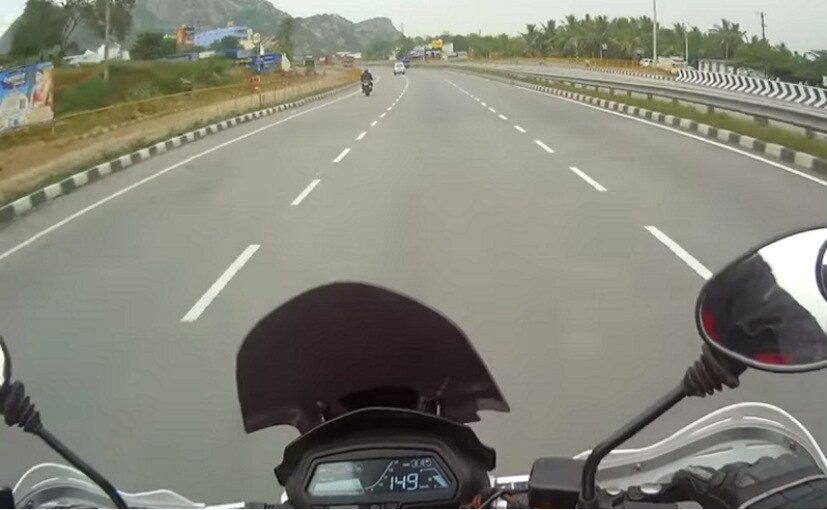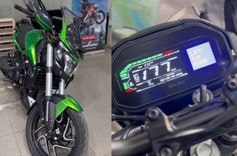Opinion: New TVS Apache RR 310S Video Puts Focus On Road Safety

- Dominar seen struggling to keep up with Apache 310
- Focus on road safety and legal speed limits
- In 2015, nearly 1.5 lakh people died in road accidents
A new video has emerged of the upcoming TVS Apache RR 310S out on a test run on a highway in southern India, shot by a rider on a Bajaj Dominar trying to get a closer look. What is clearly evident is that the Apache RR 310S packs some serious power, and the Bajaj Dominar struggles to keep up, even in high speeds exceeding 100 kmph. The video shows the Dominar exceeding speeds of over 150 kmph, but the Apache 310 still manages to pull away cleanly, eventually disappearing from the Dominar rider's view. It's apparent that the TVS accelerates faster, and also has a higher overall top speed.
But more than the performance of these bikes, the video has once again brought a more pertinent subject into focus - speed limits on highways, enforcement and road safety. Riding, or driving, at such speeds is no doubt reckless behaviour, and in this case, both riders are riding in illegal speeds on public roads. Naturally, such speeds are not only much beyond the permissible legal speed limit, but are very unsafe as well, not just for the riders, but for other motorists on the highway too. Riding at such speeds on public roads is a sure shot recipe for disaster, and it's just plain luck that no untoward incident took place while the bikes were swerving in and out of fast moving traffic.
And it's not like riding skill and experience alone can cast a safety net over riders or even drivers indulging in such irresponsible behaviour. Indian roads are one of the most dangerous in the world. Consider this - three people are killed on Indian roads in nine road accidents every 10 minutes, and road accidents account for 83 per cent of all traffic-related deaths in India. In 2015 alone, 1,48,000 people were killed due to road accidents in India. And it's the two-wheeler riders who are at more risk; two-wheeler accidents accounted for 29 per cent of all fatal accidents in 2015, followed by trucks (19 per cent), which killed 28,910 people and cars (12 per cent), which killed 18,506 people. These aren't random figures, but actual data released by the National Crime Records Bureau on Accidental Deaths and Suicides in India.
The reasons and contributing factors are many, from speeding to not following basic traffic rules and not taking even simple precautions like wearing a seat belt or helmet. But there are also other factors, like uneducated driving etiquette and dangerous driver behaviour. In 2014, speed limits on Indian highways were revised, for the first time in 25 years to 100 kmph for cars and 80 kmph for bikes. These are welcome steps, but more needs to be done, and penalising errant drivers is only one pre-emptive measure to reduce road accidents. There are grey areas as well; as highways and expressways become better and better, should there be a minimum speed limit as well on certain roads? After all, a slow moving tractor, or even a bullock cart on a highway, can be the cause of a road accident as much as a fast moving vehicle.
There's another area which requires attention. As cars and bikes become more powerful, and better equipped, it's become even more imperative to focus not only on speed limits, but also on other aspects like penalising errant drivers and licencing of vehicle operators. Fines for current traffic offences haven't been revised since 1988 and it's only logical that steeper fines will ensure more deterrence against breaking traffic rules. Then, there's the burgeoning Indian economy with disposable incomes and access to cars and bikes with some serious performance. Controlled environments like racetracks are not always accessible to owners of hi-end cars and superbikes. And with motorsport yet to be perceived as a sport, getting access to some lap time on a racetrack is neither simple, nor affordable alternative yet.
Then there's the issue of licencing. Under the current laws regarding driving licences, anyone with a licence to ride a motorcycle can ride any superbike. But no questions are asked if the licence holder has the required skills and experience to handle such hi-performance machines, when a slight twist of the wrist can spell disaster. In the West, for example, an entry-level licence holder can only ride motorcycles of up to a certain engine capacity and power output. Should India follow a similar example? Perhaps it's time to take a more pragmatic approach not just on enforcing traffic rules and speed limits, but also on taking a long-term view embracing the reality, to make India's roads safer, for all of us.
Trending News
 3 mins readWill The Kawasaki W230 Be Launched In India?
3 mins readWill The Kawasaki W230 Be Launched In India?
Latest News
 car&bike Team | Dec 24, 2025Updated Bajaj Pulsar 150 Launched At Rs 1.09 Lakh: Gets LED Lighting, New ColoursThe Pulsar 150 is offered in three variants with prices topping out at Rs 1.15 lakh (ex-showroom).2 mins read
car&bike Team | Dec 24, 2025Updated Bajaj Pulsar 150 Launched At Rs 1.09 Lakh: Gets LED Lighting, New ColoursThe Pulsar 150 is offered in three variants with prices topping out at Rs 1.15 lakh (ex-showroom).2 mins read Janak Sorap | Dec 24, 20252026 Kawasaki Ninja 650 Launched at Rs 7.91 LakhWith E20 compliance, the 2026 Ninja 650 receive a new colour update and a premium price tag.1 min read
Janak Sorap | Dec 24, 20252026 Kawasaki Ninja 650 Launched at Rs 7.91 LakhWith E20 compliance, the 2026 Ninja 650 receive a new colour update and a premium price tag.1 min read Jafar Rizvi | Dec 24, 2025Listed: Car Manufacturers That Will Hike Prices From January 2026Based on the announcements made so far, the price increase across car models is expected to range between 2 and 3 per cent.3 mins read
Jafar Rizvi | Dec 24, 2025Listed: Car Manufacturers That Will Hike Prices From January 2026Based on the announcements made so far, the price increase across car models is expected to range between 2 and 3 per cent.3 mins read car&bike Team | Dec 24, 2025KTM RC 390 Discontinued Globally, Remains On Sale In IndiaThe KTM RC 390 will continue to be offered on sale in India, where it is manufactured and there’s still strong demand for the model.2 mins read
car&bike Team | Dec 24, 2025KTM RC 390 Discontinued Globally, Remains On Sale In IndiaThe KTM RC 390 will continue to be offered on sale in India, where it is manufactured and there’s still strong demand for the model.2 mins read car&bike Team | Dec 23, 2025India Bike Week 2025 In Pictures: Highlights From Edition 12The 12th Edition of IBW was held on December 19 and 20, and if you missed this year’s festival, here is a recap of all that happened.3 mins read
car&bike Team | Dec 23, 2025India Bike Week 2025 In Pictures: Highlights From Edition 12The 12th Edition of IBW was held on December 19 and 20, and if you missed this year’s festival, here is a recap of all that happened.3 mins read Amaan Ahmed | Dec 23, 2025Tata To Enter Rs 40 Lakh Passenger Car Market With First Avinya Electric SUV In End-2026Set to be one of three EV launches from Tata Motors next year, the first in the Avinya series of electric vehicles will catapult the Pune-based carmaker into uncharted market territory, as it will be the most expensive Tata yet.1 min read
Amaan Ahmed | Dec 23, 2025Tata To Enter Rs 40 Lakh Passenger Car Market With First Avinya Electric SUV In End-2026Set to be one of three EV launches from Tata Motors next year, the first in the Avinya series of electric vehicles will catapult the Pune-based carmaker into uncharted market territory, as it will be the most expensive Tata yet.1 min read
 Jafar Rizvi | Dec 24, 2025MG Windsor EV 38 kWh Long-Term Report: IntroductionThe Windsor EV has joined our garage, and before it settles into daily duty, I took it out to get a sense of what living with an electric car is like.4 mins read
Jafar Rizvi | Dec 24, 2025MG Windsor EV 38 kWh Long-Term Report: IntroductionThe Windsor EV has joined our garage, and before it settles into daily duty, I took it out to get a sense of what living with an electric car is like.4 mins read Seshan Vijayraghvan | Dec 23, 20252026 Kia Seltos Review: Formula Is Spot On, But Is The Timing Right?The 2nd-gen Kia Seltos has arrived, but it has the challenge of facing strong rivals like the Victoris and Sierra. The question is simple - Does it still have what it takes?9 mins read
Seshan Vijayraghvan | Dec 23, 20252026 Kia Seltos Review: Formula Is Spot On, But Is The Timing Right?The 2nd-gen Kia Seltos has arrived, but it has the challenge of facing strong rivals like the Victoris and Sierra. The question is simple - Does it still have what it takes?9 mins read Seshan Vijayraghvan | Dec 22, 20252026 Tata Harrier & Safari 1.5 Hyperion Review: By The Power Of Petrol!The new Tata Harrier and Safari petrol packs a new 1.5-litre TGDI Hyperion engine, but is it an ideal alternative to the diesel version?7 mins read
Seshan Vijayraghvan | Dec 22, 20252026 Tata Harrier & Safari 1.5 Hyperion Review: By The Power Of Petrol!The new Tata Harrier and Safari petrol packs a new 1.5-litre TGDI Hyperion engine, but is it an ideal alternative to the diesel version?7 mins read Bilal Firfiray | Dec 19, 2025Maruti Suzuki e-Vitara Review: Worth The Wait?After a long wait, the first-ever electric Maruti Suzuki is here. It’s the e-Vitara, and it comes with a few promises. But arriving this late, is it worth the wait? Or is it a case of too little, too late?9 mins read
Bilal Firfiray | Dec 19, 2025Maruti Suzuki e-Vitara Review: Worth The Wait?After a long wait, the first-ever electric Maruti Suzuki is here. It’s the e-Vitara, and it comes with a few promises. But arriving this late, is it worth the wait? Or is it a case of too little, too late?9 mins read Bilal Firfiray | Dec 18, 2025Mercedes-Benz G450d: The Subtle Power of EvolutionThe Mercedes-Benz G 450d evolves subtly with more power, improved efficiency, and modern tech, while staying true to the timeless G-Class design. And character.4 mins read
Bilal Firfiray | Dec 18, 2025Mercedes-Benz G450d: The Subtle Power of EvolutionThe Mercedes-Benz G 450d evolves subtly with more power, improved efficiency, and modern tech, while staying true to the timeless G-Class design. And character.4 mins read































































































































